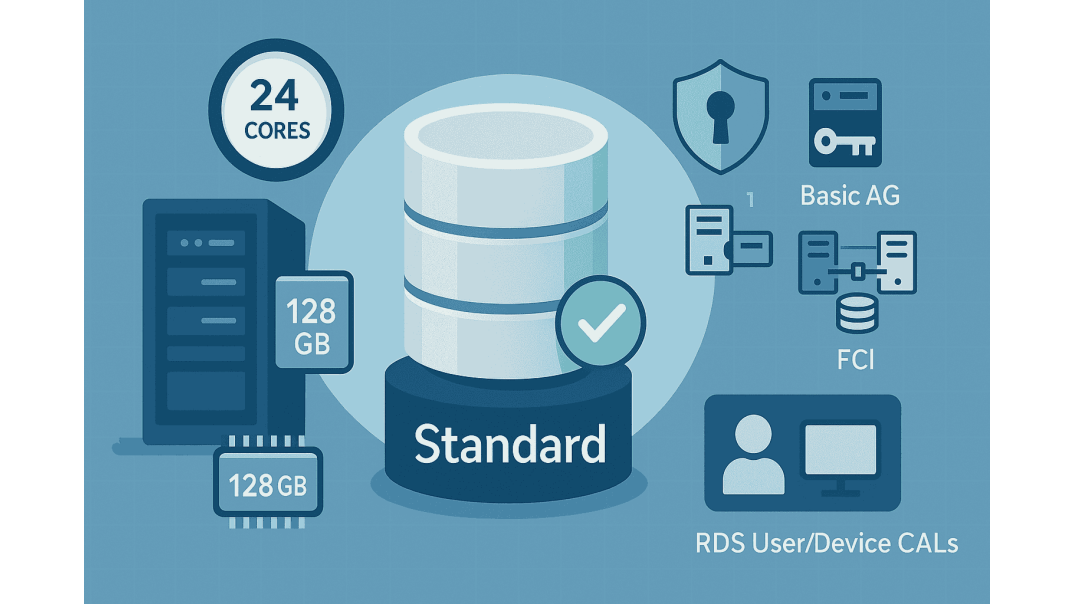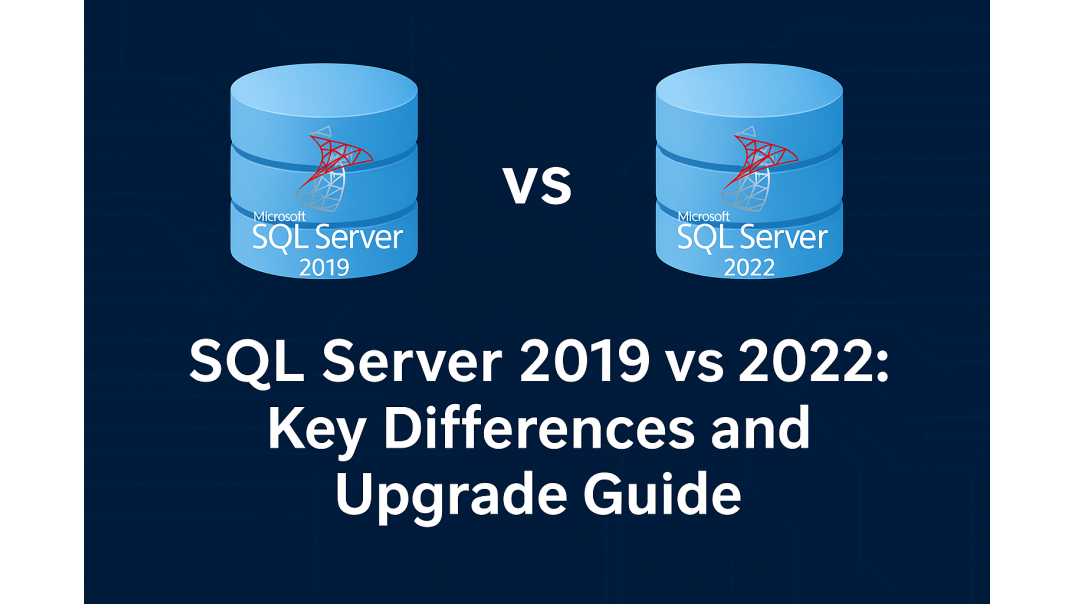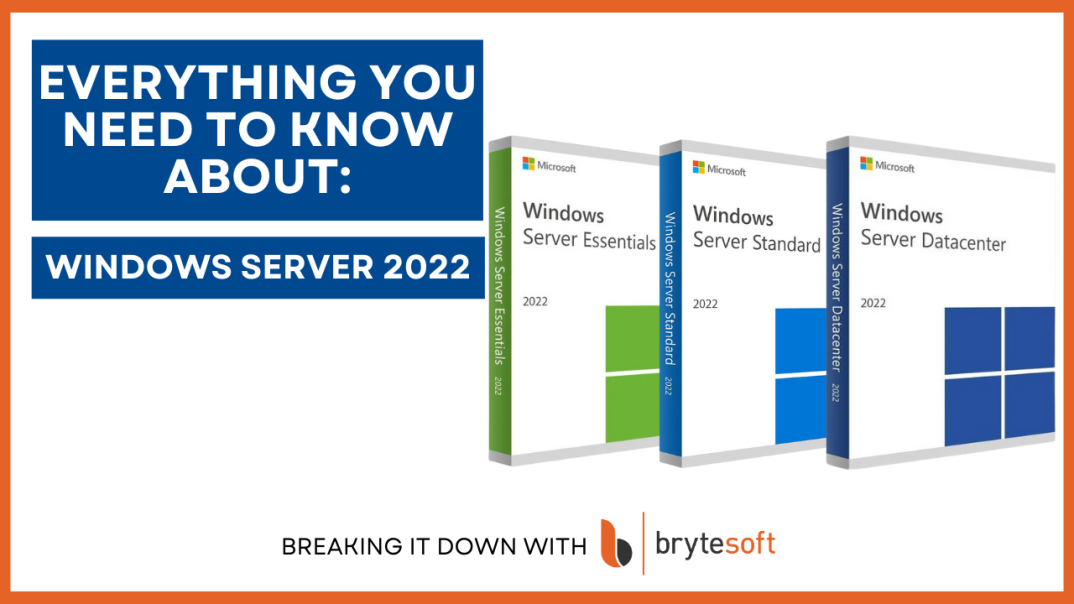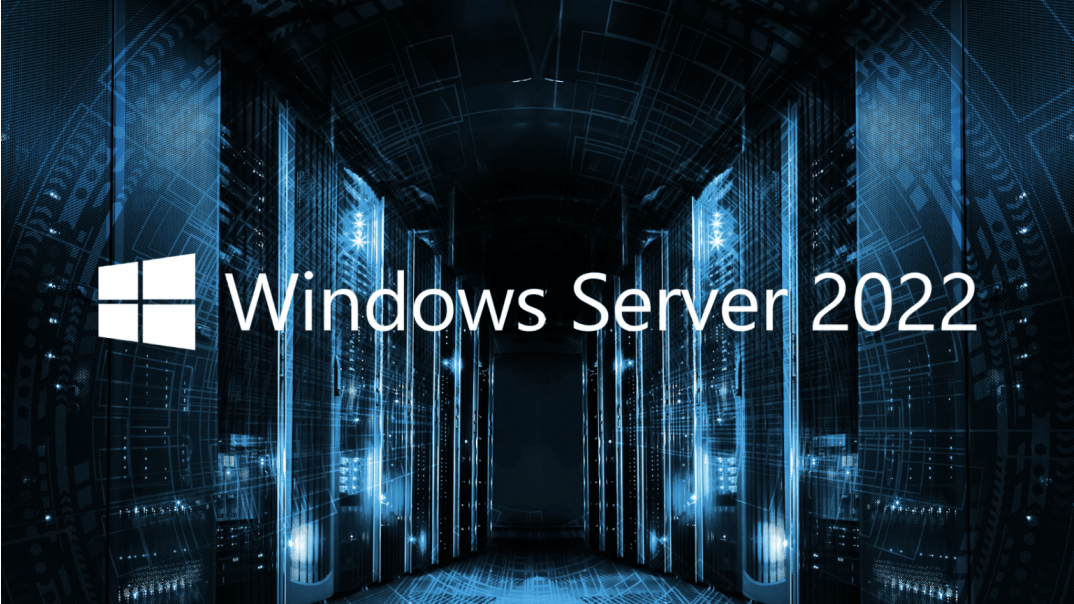When SQL Server 2022 Standard Is Enough
For many organizations, SQL Server 2022 Standard strikes the sweet spot: it offers modern security, solid performance features, and practical high availability without the overhead of pricier editions. This guide explains what Standard actually includes, the limits that matter for sizing, and how to choose the right licensing approach. We also cover Remote Desktop Services (RDS) licensing, specifically, User CALs versus Device CALs, since most teams manage SQL Server on Windows hosts and require compliant remote access.
What SQL Server 2022 Standard Includes
Modern security out of the box. Standard includes the security features most organizations ask for:
- Transparent Data Encryption (TDE) to encrypt data at rest
- Always Encrypted (with secure enclaves) for client-side encryption scenarios
- Row-Level Security and Dynamic Data Masking to minimize data exposure
- Encrypted backups and auditing hooks for compliance
Performance & analytics you’ll actually use:
- Columnstore indexes for big scan/aggregate workloads (great for reporting)
- Query Store and Intelligent Query Processing features that stabilize plans and tune tricky workloads
- Data compression (row/page) and table partitioning to manage large datasets and improve maintenance
Operational essentials:
- SQL Server Agent for scheduling jobs
- Integration with SSMS, PowerShell/SMO, and standard monitoring tooling
Scale Limits That Define “Enough”
Knowing the built-in ceilings helps you decide whether Standard fits your growth curve:
- Compute ceiling: limited to the lesser of 4 sockets or 24 cores for the Database Engine.
- Buffer pool (engine memory) per instance: 128 GB.
- Columnstore segment cache: 32 GB per instance.
- In-Memory OLTP data size: 32 GB per database.
- Batch mode degree of parallelism (columnstore): capped at 2 in Standard.
- Database size: up to 524 PB (same engine limit as higher tiers)
If your steady-state needs live under those thresholds, and most departmental OLTP/reporting stacks do, Standard is typically the cost-smart choice.
High Availability & Disaster Recovery in Standard
Basic Availability Groups (AGs) provide a straightforward HA option in Standard:
- Two replicas total (one primary + one secondary)
- Single database per AG
- No readable secondary (secondary is for failover only)
- Synchronous or asynchronous commit for HA/DR flexibility
Failover Cluster Instances (FCI).
- Supported in Standard for instance-level HA with shared storage (Windows Server Failover Clustering)
- A good fit when you want the entire SQL instance (not just one database) to move together on failover
Log shipping remains a simple, reliable DR pattern when RPO/RTO can tolerate a modest delay.
Rule of thumb: Choose Basic AG when you want database-level HA without shared storage. Choose FCI when you prefer instance-level HA with shared storage. Many customers combine FCI (local HA) with log shipping (DR) for a balanced setup.
Licensing SQL Server 2022 Standard: Per Core vs Server + CAL
You can license Standard in two ways:
Per Core
- License the cores on the SQL Server (sold in 2-core packs).
- Best for internet-facing or hard-to-count access models.
Server + CAL
- License the server and every user or device that connects to it.
- Often cheaper for line-of-business apps with a known, limited population.
How to choose:
- If you can count the population precisely and it’s relatively small/stable, Server + CAL can win on price.
- If access is broad, external, or hard to count, Per Core is simpler and safer.
- Model both options using your current core count and access patterns—then run “what-ifs” for 12–24 months of growth.
Don’t forget RDP access: RDS User vs Device CALs
Windows Server includes a couple of administrative RDP sessions for maintenance, but any regular end-user Remote Desktop access requires RDS CALs. Suppose your SQL administrators, developers, helpdesk, or power users connect to the Windows Server hosting SQL (or to a jump box/Remote Desktop Session Host). In that case, you need to license those RDP connections separately.
Two RDS CAL types and when each shines:
- RDS User CAL (best when people move between devices): Access to each person who uses RDP, and they can connect from multiple devices (laptop, home PC, thin client).
- RDS Device CAL (best for shared/shift devices): Access to each device that multiple people share—great for kiosks, warehouse stations, nursing stations, or shared helpdesk terminals.
👉 Get RDS User CALs for Windows Server 2022
Which should you pick?
- If your environment is user-centric (knowledge workers hopping between devices), User CALs are usually more economical.
- If your environment is device-centric (with fewer shared endpoints and many shift workers), Device CALs typically cost less.
- Mix and match is allowed. Many organizations deploy User CALs for staff and Device CALs for shared stations.
Version compatibility tip:
Check compatibility when your CAL version differs from the session host. For details and common upgrade scenarios, see our guide: RDS CAL Version Compatibility: A Complete Guide.
Practical sizing tips for Standard
- Plan memory first. With a 128 GB buffer pool cap, design indexing to keep hot data resident; use compression and partitioning on large tables.
- Use columnstore intentionally. Even with DOP 2 in batch mode, columnstore can massively accelerate reporting. Target wide scans and aggregations; keep segments well-compressed.
- HA drives architecture. Need DB-level HA, no shared storage, and simple failover? Basic AG. Prefer instance-level failover with shared storage? FCI.
- Keep non-prod on Developer edition. You receive full engine features in development and testing (non-production), while production remains on Standard for cost control.
Decision checklist: Is Standard enough?
Say yes to most of these and you’re likely in good shape with Standard:
- Our SQL instance stays under 24 cores and a 128 GB buffer pool.
- We don’t need readable secondaries or multi-database failover within a single group.
- Columnstore at DOP 2 still meets our reporting SLAs.
- TDE/Always Encrypted/RLS covers our compliance needs.
- Licensing math favors Per Core or Server + CAL based on our access model.
- For RDP, our pattern (users vs. shared devices) clearly aligns with RDS User CALs or RDS Device CALs and we’re covered.
If you’re consistently bumping into the core/memory caps, need read-scale replicas, or are performing complex online operations across huge datasets, revisit your architecture and budget before you outgrow Standard.
Final Thought
For a wide range of business-critical workloads, SQL Server 2022 Standard delivers exactly what most teams need: modern security, meaningful performance features, and practical HA—within sensible, predictable limits. Use those limits to your advantage: design within them, and Standard will serve you well.
Where to go next
- For upgrade: Microsoft SQL Server 2022 Standard
- Build the host: Windows Server 2022 Standard
- License remote access: RDS User CAL 2022 | RDS Device CAL 2022
- Keep reading: Windows Server 2022 Editions: A Detailed Comparison | RDS CAL Version Compatibility | SQL Server 2019 vs 2022
FAQ About SQL Server 2022: Edition Capabilities and When Standard Is Enough
Is SQL Server 2022 Standard enough for high availability?
Standard offers Basic Availability Groups (one primary, one secondary) and Failover Cluster Instances (FCI) for instance-level HA. Use Basic AG for database failover and FCI for instance failover. Pair with Windows Server 2022 Standard.
What are the key resource limits in SQL Server 2022 Standard?
Each instance supports up to 4 sockets or 24 cores, with a 128 GB buffer pool memory and 32 GB allocated for both columnstore and In-Memory OLTP data, enabling DOP 2 for departmental OLTP/reporting workloads.
Do I need RDS CALs to use SQL Server?
Users must connect through Remote Desktop to access tools on the Windows Server. RDS CALs are for Remote Desktop, not SQL. Options include: ' RDS User CAL (2022) for multiple devices ' RDS Device CAL (2022) for shared devices.
Should I buy RDS User CALs or Device CALs'and can I mix them?
Select User CALs for individuals using multiple devices and Device CALs for shared endpoints. You can mix both to suit your environment: ' RDS User CAL for Windows Server 2022 ' RDS Device CAL for Windows Server 2022
How do I choose between Per Core and Server + CAL for SQL Server 2022 Standard?
Per Core: best for internet-facing apps or when you can't reliably count users/devices. Server + CAL: often cheaper for internal line-of-business apps with a known, limited user/device population. Model both against your current cores and your 12'24-month growth. When you're ready, get SQL Server 2022 Standard from Brytesoft.







